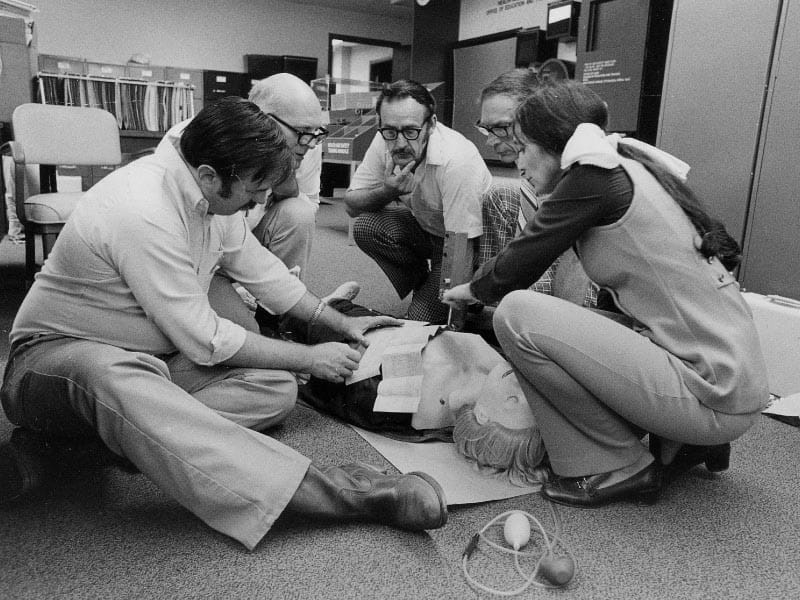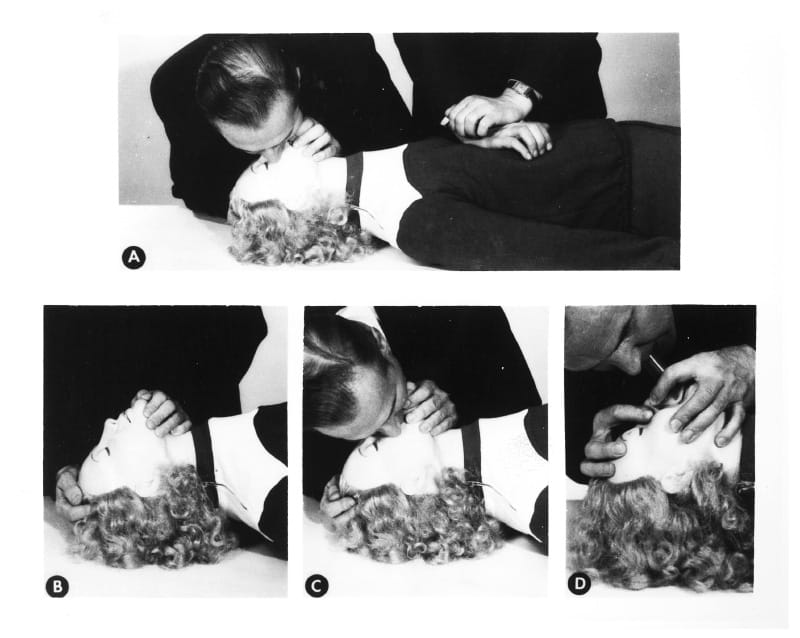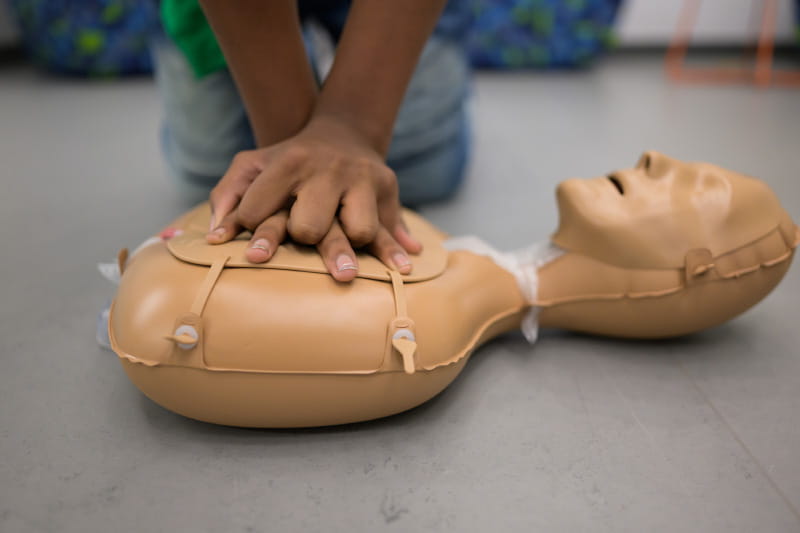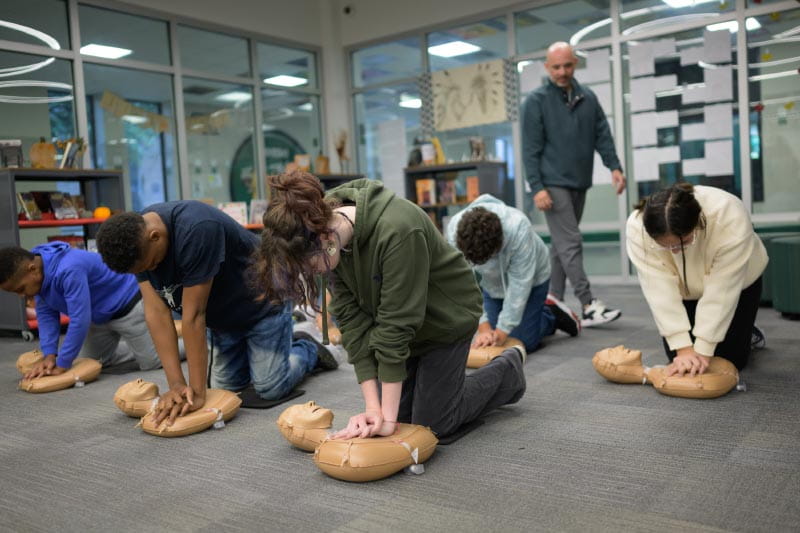Decades of CPR leadership have enhanced AHA's lifesaving mission

In 1960, a trio of physicians combined mouth-to-mouth breathing with chest compressions to create cardiopulmonary resuscitation, the lifesaving actions we now call CPR. Since then, the American Heart Association has led efforts to ensure health care workers and the public are aware of the most up-to-date resuscitation science while also advocating for critical policy and system changes.
That decades-long effort has been full of challenges — for example, how to make sure more and more laypeople are trained and willing to give effective CPR to anyone in need, and how to train health care professionals to consistently provide the highest-quality resuscitation.
Last year the AHA launched a new national CPR campaign, Nation of Lifesavers, to turn bystanders into lifesavers. The campaign has ambitious goals, including doubling the rate of survival from out-of-hospital cardiac arrest from 9% to 20% by 2030, and increasing the use of automated external defibrillators (AEDs) in public settings. AEDs deliver a shock to correct an abnormal heart rhythm and have been shown to increase survival by up to 70% if used within the first two minutes of a cardiac arrest.
"The Nation of Lifesavers campaign has already built quite a bit of momentum and is starting to make an impact on people's willingness to perform CPR in an emergency," said Tammy Gregory, the AHA's executive vice president of Healthcare Business Solutions. "AHA is the strongest when we can all rally behind a cause."
Other goals by 2030 include increasing the rate that laypeople respond to cardiac arrest with CPR to over 50% from its current 40.2% and ensuring 100% of cardiac arrest victims receive high-quality CPR within one minute and AED application within two.
Key partnerships, critical progress
Each year in the U.S. more than 350,000 people suffer an out-of-hospital sudden cardiac arrest — when the heart abruptly stops functioning. About 90% do not survive. Survival is particularly low among rural, low-income, Black, Hispanic and some Asian communities, and in women.
A person in cardiac arrest has just 600 seconds before death becomes irreversible, but immediate CPR can double or triple chances of survival. Training, and especially recent training, increases people's willingness to act.
The AHA's early involvement with CPR and skills training started decades ago with a strategic alliance that continues to this day with Laerdal Medical. The former toy and book publishing company created Resusci Anne, the world's first CPR training manikin, in 1960 after company owner Asmund Laerdal resuscitated his own toddler son who nearly drowned.

In 1963, the AHA endorsed CPR and established a CPR Committee as a step in formalizing CPR as a science. Then, in 1975, it published its first Advanced Cardiovascular Life Support textbook, paving the way for its CPR trainings and courses. Today the AHA also works with global groups on the most up-to-date research through the International Liaison Committee on Resuscitation.
This year, as the American Heart Association celebrates its centennial, it is the global leader in CPR and emergency cardiovascular care education, delivering training in over 4,000 training centers in more than 100 countries. In all, over 20 million people worldwide every year learn CPR through the AHA. In the U.S., around 90% of health care providers have received AHA training.
CPR for all
Meanwhile, the AHA has also continued to vastly increase CPR accessibility.
While experts note that the best CPR is still CPR with rescue breaths, the 2008 science-backed birth of Hands-Only CPR — chest compressions without rescue breaths — marked a shift in accessibility, meaning more people would be willing and able to be rescuers, said Liz McKnight, a senior director of product marketing for the AHA's Emergency Cardiovascular Care department. In 2012, the AHA launched a campaign to raise awareness of Hands-Only CPR to reduce barriers and increase the likelihood of people performing CPR during an emergency.
Innovative approaches to training have been key in increasing CPR accessibility. In 2005, the AHA launched its Adult & Child CPR Anytime® Kit, which people can use to learn CPR skills from home. Most recently, the association introduced an award-winning Hands-Only CPR virtual reality experience through Meta Quest.
The association is working to close CPR disparity gaps, too. "Women and people of color are much less likely to receive CPR," McKnight said.
Part of the solution is to normalize seeing these groups in training and promotional materials. Over the past two years the AHA started several new campaigns to do just that, including the Today You Were Ready campaign featuring Asian American Pacific Islanders, and Heroes Saving Hearts campaign on Latinas. The organization is also mobilizing to increase access to CPR training and AED devices in rural and low-income communities.

Expanding community reach
The American Heart Association has set out to help increase support for first responders, too. It's working to ensure EMS systems across the country have T-CPR — when EMS operators are trained to talk lay responders through CPR — provided in 100% of relevant cases within one minute.
In schools, the AHA has been active as well. It helped to solidify legislation in 40 states plus Washington, D.C., mandating CPR as a high school graduation requirement, and is working in the remaining states. A 2023 scientific review showed children as young as 10 are ready to be CPR trained, while those as young as 4 can play a part, too. The AHA regularly updates its CPR guidance to reflect new scientific research.
The AHA's relationship with Buffalo Bills player Damar Hamlin, whose heart stopped during a game and who was revived on the field, and NFL-founded Smart Heart Sports Coalition, is helping to ensure that high schools have funds to create an athletic emergency action plan around cardiac emergencies, plus AEDs available at athletic venues, and CPR-and AED-trained coaches.
"Damar Hamlin's event really put CPR on the map again for everybody," Gregory said. The AHA-backed Access to AEDs Act, which Hamlin spoke in support of in Washington, D.C., would authorize federal funding to purchase AEDs and provide CPR and AED training in schools. In addition, the Cardiomyopathy Health Education, Awareness, Research and Training in Schools (HEARTS) Act would help ensure students and school staff are prepared to respond to a cardiac emergency.
To date seven states require schools to have cardiac emergency plans, and 17 states require these plans for school athletic facilities and events.

A new training schedule
Finally, the AHA has been instrumental in helping to refine how health care professionals receive training. In 2015, in collaboration with Laerdal, the AHA introduced Resuscitation Quality Improvement® (RQI®), a research-backed digital CPR training program through which health care professionals engage in low-dose, high-frequency CPR training sessions every quarter rather than a single course every two years. Data show that more frequent training can help professionals elevate their competence and confidence to perform high-quality CPR — the cornerstone for cardiac arrest survival.
"That was a huge shift in quality improvement for providers," McKnight said.
More than 3 million health care professionals globally are now enrolled in AHA digital resuscitation training programs, including RQI. "RQI is an innovation that has proven not only to improve the quality of CPR and in-hospital mortality rates of sudden cardiac arrest patients, but also can save hospitals money," as off-site training expenses drop, Gregory said.
Gregory and McKnight expect the AHA to continue its global leadership to drive innovations like these as it forges ahead to raise cardiac arrest survival rates. "I see the AHA continuing to make CPR and AED use even more accessible, equitable and consistent," McKnight said.





